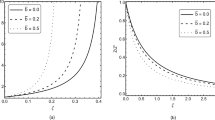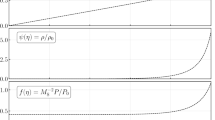Abstract
An approximate method for finding the parameters of the shock wave which forms during motion of a meteoric body in the atmosphere at high supersonic speed is described via the conventional gasdynamic formulas after preliminary determination of the effective adiabatic exponent. The energy losses in dissociation and ionization of the air are accounted for.
Similar content being viewed by others
References
F. A. Baum, S. A. Kaplan, and K. P. Stanyukovich, Introduction to Cosmic Gasdynamics [in Russian], Fizmatgiz, Moscow, 1958.
I. B. Rozhdestvenskii, “Thermodynamic and gasdynamic properties of air flow behind a normal compression shock with account for dissociation and ionization of the air,” collection: Physical Gasdynamics [in Russian], Izd-vo AN SSSR, Moscow, 1959.
V. A. Bronshtén, “Problems of the motion of large meteorites,” Meteoritika, Nauka, Moscow, no. 24, 1964.
V. A. Bronshten, “Theory and spectral study of meteorite-forming bolides,” Meteoritika, Nauka, Moscow, no. 27, 1966.
Author information
Authors and Affiliations
Rights and permissions
About this article
Cite this article
Stanyukovich, A.K. Approximate determination of the shock-adiabat exponent for motion of large meteoric bodies in the atmosphere. J Appl Mech Tech Phys 10, 275–276 (1969). https://doi.org/10.1007/BF00913116
Issue Date:
DOI: https://doi.org/10.1007/BF00913116




